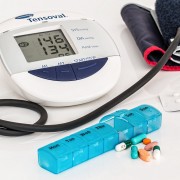Hypertension Risks For Seniors
Blood pressure is calculated by the amount of blood the heart pumps and the amount of resistance to that blood flow in a person’s arteries. The more blood that pumps combined with the more resistance there is creates high blood pressure. Narrow arteries cause more resistance and therefore cause higher blood pressure.
Hypertension, otherwise known as high blood pressure happens over time and can be present for years without any symptoms. Even without symptoms, however, high blood pressure causes damage to the blood vessels and heart. A person may not even know they have it because high blood pressure can be present without symptoms. Uncontrolled high blood pressure increases your risk of serious health problems, including heart attack and stroke. However, the good news is, high blood pressure is easily detected.
What’s Is The Normal Blood Pressure For Seniors?
Blood Pressure Normal Range:
Less than 120 for systolic (upper number)
Less than 80 for diastolic (lower number)
Blood Pressure Elevated Range:
Between 120 and 129 (upper number)
Less than 80 (lower number)
High Blood Pressure Stage 1:
Between 130-139 (upper number)
Between 80-89 (lower number
High Blood Pressure Stage 2:
140 or higher (upper number)
90 or higher (lower number
Crisis = You must CONSULT YOUR PHYSICIAN
180 or higher (upper number)
Higher than 120 (lower number)
What Are The Signs & Symptoms Of High Blood Pressure?
Most people with high blood pressure have no signs or symptoms, even if blood pressure readings reach dangerously high levels. People who do experience symptoms may have headaches, shortness of breath, or nosebleeds. However, these signs and symptoms aren’t specific and usually don’t occur until high blood pressure has reached a severe or life-threatening stage.
Are There Hypertension Risk Factors?
Risk factors for Hypertension may include:
- Age
- Race
- Stress
- Family history
- Using tobacco
- Being overweight or obese
- Not being physically active
- Too much salt in your diet
- Too little potassium in your diet
- Drinking too much alcohol
- Certain chronic conditions such as kidney disease and diabetes
Importance Of Checking Your Blood Pressure
It is important to have your blood pressure checked regularly especially because symptoms may not be present. Public blood pressure machines, such as those found in pharmacies, may provide helpful information about your blood pressure, but have some limitations. The accuracy of these machines depends on several factors, such as a correct cuff size and proper use of the machines.
Sudden Onset Of High Blood Pressure
A sudden onset of high blood pressure may be the symptom of an underlying condition and could include:
- Kidney problems
- Adrenal gland tumors
- Thyroid problems
- Physical defect from birth
- Medication side effect
- Birth control pills
- Cold remedies
- Decongestants
- Obstructive sleep apnea
- Some prescription drugs
- Over-the-counter pain relievers
- Illegal drugs, such as cocaine and amphetamines
Are There Risks Of Chronic High Blood Pressure?
Complications that can result from chronic Hypertension include:
- Dementia
- Heart attack or stroke
- Aneurysm
- Heart failure
- Trouble with memory or understanding
- Weakened and narrowed blood vessels in your kidneys
- Thickened, narrowed or torn blood vessels in the eyes
Effective Ways To Lower Blood Pressure
Some effective ways to lower high blood pressure include:
- Exercise
- Reduce stress
- Drink less alcohol
- Reduce sodium in diet
- Lose weight
- Quit smoking
- Eat fresh fruits and vegetables
- Reduce sugar and refined carbohydrates in died
Orchard at Athens is a senior living community in Athens GA committed to supporting a healthy lifestyle. Nutrition, walking paths, exercise, yoga and meditation will support residents in keeping their blood pressure managed.
Smaller living neighborhoods are designed for connection and relationship opportunities that allow for collaboration and motivation toward good health. Orchard at Athens also provides onsite access to medical practitioners specializing in chronic conditions and functional medicine. Both of these affiliate partners focus on the overall health of a person which includes reducing and managing Hypertension.
Fragile X-Associated Tremor/Ataxia Syndrome
Orchard at Athens is a senior community in Athens that is committed to supporting people with a variety of needs. This also includes the many different types of neurocognitive disorders commonly called dementia.
Currently there are over 110 medical conditions causing the symptoms of dementia. Unlike many senior living communities, the staff at Orchard is uniquely trained to support people living with a variety of neurocognitive disorders. Teams specialize in the unique behavioral expressions and symptoms that vary in changing states and stages of neurodegenerative progression. One dementia that is not as common as some is, FXTAS or Fragile X-Associated Tremor/Ataxia Syndrome.
What Is Fragile X-Associated Tremor/Ataxia Syndrome?
Fragile X-Associated Tremor/Ataxia Syndrome (FXTAS) is a late onset form of the progressive cognitive disorder that occurs in people older than 50 years of age.
Affected individuals have areas of damage in the part of the brain that controls movement (the cerebellum) and in a type of brain tissue known as white matter, which can be seen with magnetic resonance imaging (MRI). This damage leads to the movement problems and other impairments associated with FXTAS.
Symptoms of Fragile X-Associated Tremor/Ataxia Syndrome
Fragile X is characterized by:
- Tremors when making purposeful movements
- Challenges with balance
- Muscle stiffness and rigidity
- Memory loss
- Challenges with movement
- Challenges with thinking and cognition
- Inability to initiate purposeful action
- Changes in behavior
- Changes in ability to initiate or complete activities of daily living (ADL’s)
- Presentations of Parkinson’s-like symptoms
Fragile X Tremors & Movement Problems
The characteristic features of FXTAS are intention tremors, which is trembling or shaking of a limb when trying to perform a voluntary movement such as reaching for an object, and problems with coordination and balance (ataxia). Typically, intention tremors will develop first, followed a few years later by ataxia, although not everyone with FXTAS has both features.
Many affected individuals develop other movement problems such as the pattern of movement abnormalities known as parkinsonism, which includes tremors when not moving (resting tremor), rigidity, and unusually slow movement (bradykinesia). Individuals may also have reduced sensation, numbness or tingling, pain, or muscle weakness in the lower limbs. Some people also experience problems with the autonomic nervous system, which controls involuntary body functions, leading to the inability to control the bladder or bowel.
Many people with FXTAS experience anxiety, depression, moodiness, or irritability. They may develop cognitive disabilities including short-term memory loss or loss of executive function, which is the ability to plan and implement actions and develop problem-solving strategies. These changes will impair skills such as impulse control, self-monitoring, focusing attention appropriately, and cognitive flexibility.
How Common Is Fragile X-Associated Tremor/Ataxia Syndrome?
Studies show that approximately 1 in 450 males have the genetic change that leads to FXTAS, although the condition occurs in only about 40 percent of them. It is estimated that 1 in 3,000 men over age 50 are affected. Similarly, 1 in 200 females has the genetic change, but only an estimated 16 percent of them develop signs and symptoms of FXTAS
Caregivers & Fragile X
Caring for someone living with this rare condition can carry similar stresses experienced by caregivers of other chronic degenerative disorders, such as Alzheimer’s or Parkinson’s disease.
Numerous investigators have reported that caregivers of individuals with these diseases are likely to experience depression, fatigue, and isolation. Orchard at Brookhaven’s philosophy in care includes family and primary care partners, not just residents needing support and assistance due to medical conditions.
Orchard’s collaboration with families includes care planning, medical coordinating, education, personal counseling, and a partnership that can lead to improved quality of life for both the care partner and the person living with a medical condition.
If you know someone living with Fragile X-Associated Tremor/Ataxia Syndrome in the Athens area, please contact us for more information and support.
Neurocognitive Disorder and CTE Chronic Traumatic Encephalopathy
Over the past 30 years, research has linked moderate and severe traumatic brain injury to a greater risk of developing a neurocognitive disorder such as Alzheimer’s disease or another dementia years after the original head injury.
Brain Injury & Risk For Developing Alzheimer’s
A history of traumatic brain injury creates a greater risk for developing Alzheimer’s:
- 3 times greater risk if moderate
- 5 times greater risk if severe
There is no evidence a single mild brain injury increases the risk of developing Alzheimer’s, however, evidence does suggest that repeated mild traumatic brain injuries, such as those that can occur in sports like American football, boxing, hockey and soccer, may be linked to a greater risk of chronic traumatic encephalopathy (CTE), a form of dementia.
Repeated Brain Injury & Increased Risk of Dementia
There is evidence that the repetition of trauma to the brain could be a key factor in developing a neurocognitive disorder. A study published in the March 23, 2016, online edition of the Journal of Neurology found that a history of traumatic brain injury may accelerate the age of onset of cognitive impairment by two or more years. Another study conducted by researchers at Umea University in Sweden confirmed traumatic brain injury as a risk factor for dementia and revealed that the risk of a dementia diagnosis was highest during the first year after the injury. During this time, people who had a traumatic brain injury were four to six times as likely to get a dementia diagnosis as those without a traumatic brain injury.
Orchard at Athens understands dementia symptoms come in many unique packages. Our team has years of experience working directly with people living with dementia in the Athens area who suffered from various conditions, including brain injury. Our experiences and observations have allowed us to use new approaches in care that start with building a relationship with the person who is going to be offered care services.
Brain Injury & Risk of CTE
Previous research has shown that boxers have an increased risk of CTE, which was originally called dementia, or “punch-drunk syndrome.”
The risk of CTE in boxers seems most closely tied to the number of rounds boxed, not to the number of times a boxer was knocked out, suggesting that even repeated mild traumatic brain injuries that don’t cause unconsciousness may increase dementia risk.
Researchers don’t yet know whether CTE is most likely to occur following a small number of severe traumatic brain injuries, a large number of mild or very mild traumatic brain injuries, or some other pattern of head trauma.
CTE Symptoms
The symptoms of CTE may include:
- Memory loss
- Confusion
- Impaired judgment
- Impulse control problems
- Aggression
- Depression
- Anxiety
- Suicide Ideation
- Parkinsonism (movement symptoms similar to Parkinson’s disease),
- These symptoms may begin years or even decades after the last traumatic brain injury
Current research on how traumatic brain injury changes brain chemistry indicates a relationship between traumatic brain injury and the protein abnormalities linked to Alzheimer’s. Within hours after injury, severe traumatic brain injury has been shown to increase levels of beta-amyloid, one Alzheimer’s protein. And CTE, the dementia linked to repeated mild traumatic brain injury, appears to be most strongly characterized by deposits of tau protein.
According to the Boston University CTE Center, Chronic Traumatic Encephalopathy (CTE) is a degenerative brain disease. Every person diagnosed with CTE has one thing in common: a history of repetitive hits to the head. CTE is most often found in contact sport athletes and military veterans, likely because these are some of the only roles in modern life that involve purposeful, repetitive hits to the head.
Differentiating Injury Severity
The severity of symptoms of traumatic brain injury depends on whether the injury is mild, moderate or severe. Mild traumatic brain injury, also known as a concussion, either doesn’t cause unconsciousness or unconsciousness lasts for 30 minutes or less.
Mild traumatic brain injury symptoms may include:
- Inability to remember the cause of the injury or events that occurred immediately before or up to 24 hours after it happened
- Confusion and disorientation
- Difficulty remembering new information
- Headache
- Dizziness
- Blurry vision
- Nausea and vomiting
- Ringing in the ears
- Trouble speaking coherently
- Changes in emotions or sleep patterns.
These symptoms often appear at the time of the injury or soon after, but sometimes may not develop for days or weeks. Mild traumatic brain injury symptoms are usually temporary and clear up within hours, days or weeks; however, on occasion, they can last months or longer.
Moderate traumatic brain injury causes unconsciousness lasting more than 30 minutes but less than 24 hours, and severe traumatic brain injury causes unconsciousness for more than 24 hours. Symptoms of moderate and severe traumatic brain injury are similar to those of mild traumatic brain injury, but more serious and longer-lasting.
If you or someone you know has a history of traumatic brain injury, it is best to see a doctor to get a cognitive exam.
If you have more questions regarding this topic, contact us. Orchard serves residents who are living with traumatic brain injury in the Athens area and provides support for families wanting to learn more about dementia.
Frontal Temporal Dementia
Frontal Temporal Dementia (FTD) is quite different from Alzheimer’s disease as new learning and memory problems are usually not the first symptom or challenge a person will experience. Since the condition predominantly starts with either behavior or language problems, it is frequently mis-diagnosed as a psychiatric condition instead of a dementia related illness.
Signs of Frontal Temporal Dementia
Here are some facts and points about FTD:
- Progression of FTDs may look very different than other forms of dementia
- It is possible to have a mixed picture diagnosis that will include a combination of FTD and another dementia. Most common is FTD plus Alzheimer’s Disease.
- FTD symptoms will often begin at a much younger age than a typical Alzheimer’s diagnosis (40-55 versus over 70).
- Some forms of FTD will have characteristics similar to that of Parkinson’s Disease.
- The use of typical Alzheimer’s medications may have little or no effect, and in some cases may make behaviors worse in the early stages of some FTDs
What Is Frontal Temporal Dementia?
FTDs are a group of neurological conditions that progressively damages brain tissue, starting at the front part (frontal lobe) of the brain.
Early detection and diagnosis combined with the appropriate support and careful use of certain medications can make a difference in well-being.
Who Does Frontal Temporal Dementia Affect?
- At this time, more men than women diagnosed with FTD.
- Risk is higher, if there are close blood relatives with FTD, but a clear genetic link has not been identified.
There are multiple forms of this dementia, which will discuss in more detail below.
Frontal Lobe Dementia (FvFTD or FLD)
These individuals will have changes first in their left frontal lobe and may include:
- Behavior or expressions that are not socially acceptable. For example, a person may sing loudly in a quiet or public space, eat off another person’s plate in a restaurant, urinate on an artificial tree in a mall, or make derogatory or judgmental comments directly to someone.
- Impulsivity. Persons living with FTD will take risks and have poor judgment about safety. They may drive fast or risky, shop lift, mis-handle money, use weapons, over-eat, drink excessive alcohol, damage existing relationships, and be over-active sexually or aggressive.
- Shows dis-inhibition, be overly friendly, or try to be humorous.
- Inability to begin tasks or activities.
- Difficulty making decisions.
- Will become fixated on ideas or actions.
- Unable to stay focused or complete activities.
- Not know how to behave in various social situations.
- Unable to see how their behavior or words affect others.
- Lack of personal hygiene.
- Unable to change how a problem is approached or considered.
- Repeat the same movement or action over and over (pulls hair, taps a finger, claps, smacks lips, etc.)
- Manipulative actions such as picking up and handling or fidgeting with objects and items they find.
- Putting things in their mouth or eating excessive amounts of salt, fat, and sugar foods. It is common for people to experience weight gain due to compulsive eating or drinking.
- Language may be impulsive but not lost.
Temporal Lobe Dementia
These individuals will present with speaking and comprehension of language problems. Damage is first noted in the left temporal lobe of the brain.
Primary-Progressive Aphasia
Non-Fluent Aphasia symptoms include:
- Difficulty finding the names of objects
- Hesitant production of words – slowed speech or stuttering
- Not speaking or speaking very little
- Worsening of speech production over time
- Repetition of words that are heard over and over
- Saying the wrong words sometimes known as ‘word salad’
- There may also be problems understanding spoken and written words as well change in speaking ability
- Non-language skills are often NOT affected at first and the person may be able to perform most other personal activity without difficulty at first
Semantic Dementia
Fluent Aphasia symptoms include:
- Problems with naming items and with understanding the meaning of words
- Continued ability to produce the rhythm of speech so it will sound like the person is saying something, but the words will not make sense
- There may be pauses in speech to find a specific word, otherwise speech is smooth and seems like it should have more content
- The person may repeat their phrases and ‘important’ words over and over during conversations without being aware of the repeats
- Facial expressions and gestures may continue to occur during speech
Frontal-Temporal Dementia – (FTD, FTLD, Pick’s Disease)
This condition includes brain change in the frontal and temporal lobes and can include Pick’s bodies found in microscopic inspection of brain tissue after death. Symptoms can include:
- Change in impulsivity, dis-inhibition, hyper-orality, decreased attention, perseveration of speech and action, stereotypical actions and words, loss of empathy and social awareness
- Decreased speech production, struggles with language and comprehension, outbursts of song or inappropriate words or phrases, or echolalia; the uncontrollable and immediate repetition of words spoken by another person
- Difficulty thinking things through, concentrating on tasks, loss of problem solving
- As the disease progresses, symptoms worsen and then other problems develop that present more like Alzheimer’s disease.
Contact Orchard at Athens if you have questions about Frontal Temporal Dementia. The clinical team at Athens is specifically trained to support people living with this type of dementia.
Orchard’s “Communities within a Community” Spectrum of Care model includes small neighborhoods that will allow residents to have support and services based on differing acuity’s that reside within an assisted living and memory care setting.
Additional Resources on Fronto-Temporal Dementias:
Signs & Symptoms Of Alcohol Related Dementia
Alcohol Related Dementia (ARD) refers to a form of dementia caused by long-term, excessive consumption of alcoholic beverages, resulting in neurological damage and impaired cognitive function. It is well established that excessive and prolonged alcohol use can lead to permanent damage to the structure and function of the brain. Evidence also suggests a relationship between moderate to heavy consumption of alcohol to cognitive impairment. While Alcohol-induced persistent dementia or alcohol-related dementia is widely acknowledged, the diagnosis is not often used.
Signs & Symptoms Of Alcohol Related Dementia
Some signs and symptoms of ARD include:
- Confusion and loss of mental activity
- Loss of muscle coordination
- Abnormal eye movements, such as back and forth movements
- Double vision
- Eyelid drooping
- Inability to form new memories
- Loss of memory
- Confabulation
- Hallucinations
Alcohol has a direct effect on brain cells, resulting in poor judgment, difficulty making decisions, and lack of insight. Nutrition problems which often accompany long time alcohol abuse can be another contributing factor, since parts of the brain may be damaged by vitamin deficiencies. Autopsy evaluations suggest that up to 78% of individuals with diagnosed alcoholism demonstrate some degree of brain pathology
Recommended Alcohol Intake For Seniors
The Department of Health has set drinking recommendations to:
- No more than 3-4 units daily for men
- No more than 2-3 units daily for women
Drinking in excess of this recommendation and long-term alcohol consumption is considered to be generally harmful. Specific alcohol is less important than the quantity and patterns of drinking. Studies also suggest that individuals with ARD are often socially isolated, more likely to be men, and typically have a younger age of onset than those with other forms of dementia.
Can Alcohol Related Dementia Be Reversed?
The decline in cognitive or physical functioning in alcohol-related dementia is relatively non-progressive in abstinent ex-drinkers, or even partially reversible. There may be improvement with an increase in brain volume over a period of up to a year in recovering alcoholics.
Studies suggest recovery improvement can include:
- Working memory
- Visual and spatial functioning
- Problem solving
- Attention
Recovery of cognitive skills appears to be linked to the amount of recent alcohol use and duration of abstinence rather than lifetime alcohol consumption. Impairments in areas of learning and short-term memory are more persistent. Multiple withdrawals and binge drinking may significantly exacerbate cognitive deficits. Older drinkers show greater alcohol-related cognitive changes and are less likely to recover function once they cease drinking.
Because of the evidence that suggests that alcohol-related dementia is less progressive than Alzheimer’s disease, and even partially reversible, these factors may be important in finding the most living supportive environment.
Alcohol Related Dementia Support
When looking at senior living in Athens, it will be important that the staff and community are able to support someone with alcohol-related dementia. The staff of Orchard at Athens will work with you and your family to find creative solutions to support your loved one. Contact us to learn more about our community and programs.
Depression & Aging
Depression is one of the most common mental health disorders affecting 7% of adults in the United States in any given year. According to the World Health Organization, it is the leading cause of worldwide disability. Men and women may experience depression differently. Women are affected twice as often, however men are more prone to suicide as a result of depression. In this article we’ll discuss more about depression and aging.
Is It Sadness Or Depression?
Everyone has felt depressed due to circumstances in their life. However, for most people, this sadness is temporary. Depression is more than just feeling sad or blue due to a circumstance. It is a common but serious mood disorder that needs treatment. Depression is accompanied with severe symptoms that affect how a person feels, thinks, and function in day to day life.
Clinical depression, or major depressive disorder, is relatively long-lasting, can get worse over time, and significantly interferes with a person’s daily activities. A common misperception is that depression is a sign of weakness or a character flaw that someone should be able to snap themselves out of. However, most people who experience depression need support or treatment to get better.
Depression & Aging
Depression is a common problem among older adults, but it is NOT a normal part of aging. In fact, studies show that most older adults feel satisfied with their lives, despite having more illnesses and physical challenges.
However, important life changes happen as we get older and typically can cause feelings of uneasiness, stress, anxiety or sadness. Examples include:
- The death of a loved one
- Moving into a senior living community
- Dealing with a serious illness
- Retirement
- Children moving away
- Changing roles within a family
- Experiencing isolation
- Loss of productive and purposeful work/activity
Signs Of Depression With Aging
Signs of depression can include the following:
- Persistent sad, anxious, or “empty” mood
- Feelings of hopelessness, guilt, worthlessness, or helplessness
- Irritability, restlessness, or having trouble sitting still
- Loss of interest in once pleasurable activities, including sex
- Decreased energy or fatigue
- Moving or talking more slowly
- Difficulty concentrating, remembering, making decisions
- Difficulty sleeping, early-morning awakening, or oversleeping
- Frequent crying
- Eating more or less than usual, usually with unplanned weight gain or loss
- Thoughts of death, suicide, or suicide attempts
- Aches, pains, headaches, cramps, or digestive problems without a clear physical cause that do not ease with treatment
If you have a combination of these signs persisting for more than 2 weeks, you could be suffering from depression.
Depression In Older Adults
Depression in older adults may be difficult to recognize because often sadness is not the main symptom. Elders may have other, less obvious symptoms of depression and may not be willing to talk about their feelings.
Signs Of Depression In Older Adults
Some of the more common signs of depression in older adults can include the following:
- Feeling tired
- Trouble sleeping
- Seeming irritable or grumpy
- Confusion
- Attention problems
Older adults may be taking medications with side effects that contribute to depression or have medical conditions, such as heart disease, stroke, or cancer, which may cause symptoms.
Vascular Depression
With older adults who experience depression for the first time later in life, the depression can be related to changes that occur in the brain and body. Older adults may suffer from restricted blood flow and over time, vessels may stiffen and prevent the blood from flowing normally to the body’s organs, including the brain.
When this happens, an older adult with no family history of depression may develop what is sometimes called “vascular depression” due to lack of oxygenation. Those with vascular depression are also typically at risk for heart disease, stroke, or other vascular illness.
Orchard at Athens seeks to prevent depression for residents through education, collaboration, and encouraging activities for the body, mind and spirit. Transitional counseling, private therapy, support groups, assessment, and medical treatment are all available should depression be of concern. For more information please contact us.
Frontal Temporal Dementia
Frontal Temporal Dementia (FTD) is quite different from Alzheimer’s disease as new learning and memory problems are usually not the first symptom or challenge a person will experience. Since the condition predominantly starts with either behavior or language problems, it is frequently mis-diagnosed as a psychiatric condition instead of a dementia related illness.
Signs of Frontal Temporal Dementia
Here are some facts and points about FTD:
- Progression of FTDs may look very different than other forms of dementia
- It is possible to have a mixed picture diagnosis that will include a combination of FTD and another dementia. Most common is FTD plus Alzheimer’s Disease.
- FTD symptoms will often begin at a much younger age than a typical Alzheimer’s diagnosis (40-55 versus over 70).
- Some forms of FTD will have characteristics similar to that of Parkinson’s Disease.
- The use of typical Alzheimer’s medications may have little or no effect, and in some cases may make behaviors worse in the early stages of some FTDs
What Is Frontal Temporal Dementia?
FTDs are a group of neurological conditions that progressively damages brain tissue, starting at the front part (frontal lobe) of the brain.
Early detection and diagnosis combined with the appropriate support and careful use of certain medications can make a difference in well-being.
Who Does Frontal Temporal Dementia Affect?
- At this time, more men than women diagnosed with FTD.
- Risk is higher, if there are close blood relatives with FTD, but a clear genetic link has not been identified.
There are multiple forms of this dementia, which will discuss in more detail below.
Frontal Lobe Dementia (FvFTD or FLD)
These individuals will have changes first in their left frontal lobe and may include:
- Behavior or expressions that are not socially acceptable. For example, a person may sing loudly in a quiet or public space, eat off another person’s plate in a restaurant, urinate on an artificial tree in a mall, or make derogatory or judgmental comments directly to someone.
- Impulsivity. Persons living with FTD will take risks and have poor judgment about safety. They may drive fast or risky, shop lift, mis-handle money, use weapons, over-eat, drink excessive alcohol, damage existing relationships, and be over-active sexually or aggressive.
- Shows dis-inhibition, be overly friendly, or try to be humorous.
- Inability to begin tasks or activities.
- Difficulty making decisions.
- Will become fixated on ideas or actions.
- Unable to stay focused or complete activities.
- Not know how to behave in various social situations.
- Unable to see how their behavior or words affect others.
- Lack of personal hygiene.
- Unable to change how a problem is approached or considered.
- Repeat the same movement or action over and over (pulls hair, taps a finger, claps, smacks lips, etc.)
- Manipulative actions such as picking up and handling or fidgeting with objects and items they find.
- Putting things in their mouth or eating excessive amounts of salt, fat, and sugar foods. It is common for people to experience weight gain due to compulsive eating or drinking.
- Language may be impulsive but not lost.
Temporal Lobe Dementia
These individuals will present with speaking and comprehension of language problems. Damage is first noted in the left temporal lobe of the brain.
Primary-Progressive Aphasia
Non-Fluent Aphasia symptoms include:
- Difficulty finding the names of objects
- Hesitant production of words – slowed speech or stuttering
- Not speaking or speaking very little
- Worsening of speech production over time
- Repetition of words that are heard over and over
- Saying the wrong words sometimes known as ‘word salad’
- There may also be problems understanding spoken and written words as well change in speaking ability
- Non-language skills are often NOT affected at first and the person may be able to perform most other personal activity without difficulty at first
Semantic Dementia
Fluent Aphasia symptoms include:
- Problems with naming items and with understanding the meaning of words
- Continued ability to produce the rhythm of speech so it will sound like the person is saying something, but the words will not make sense
- There may be pauses in speech to find a specific word, otherwise speech is smooth and seems like it should have more content
- The person may repeat their phrases and ‘important’ words over and over during conversations without being aware of the repeats
- Facial expressions and gestures may continue to occur during speech
Frontal-Temporal Dementia – (FTD, FTLD, Pick’s Disease)
This condition includes brain change in the frontal and temporal lobes and can include Pick’s bodies found in microscopic inspection of brain tissue after death. Symptoms can include:
- Change in impulsivity, dis-inhibition, hyper-orality, decreased attention, perseveration of speech and action, stereotypical actions and words, loss of empathy and social awareness
- Decreased speech production, struggles with language and comprehension, outbursts of song or inappropriate words or phrases, or echolalia; the uncontrollable and immediate repetition of words spoken by another person
- Difficulty thinking things through, concentrating on tasks, loss of problem solving
- As the disease progresses, symptoms worsen and then other problems develop that present more like Alzheimer’s disease.
Contact Orchard at Athens if you have questions about Frontal Temporal Dementia. The clinical team at Athens is specifically trained to support people living with this type of dementia.
Orchard’s “Communities within a Community” Spectrum of Care model includes small neighborhoods that will allow residents to have support and services based on differing acuity’s that reside within an assisted living and memory care setting.
The Cypress Grove (a dementia support and assistance neighborhood) has 17 apartments and was specifically designed to care for someone living with a Rare Dementia such as FTD. The staff’s comprehensive training will include nonjudgmental and empathic approaches to the unique behavioral expressions that most often accompany conditions described.
Additional Resources on Fronto-Temporal Dementias:
Vascular Dementia: Vascular Neurocognitive Disorder
In this article we’re going to talk about Vascular Dementia. With this type of dementia, oxygen and blood flow that provides the necessary nourishment of the nerve cells and brain are disrupted. There are three major reasons this can happen; bleeding, blockage, or limiting the flow of blood.
In these instances, the brain cells not getting nourishment die, unless other blood vessels nearby take over the task. The specific symptoms the person will show depend on what structures or parts of the brain are being injured with the change of blood flow. With some of these events, the person may show an improvement after a few days, but the person typically does not make a full recovery. Below we’ll discuss more about each reason.
Bleeding
One cause is an event that leads to bleeding. The nerve cells become damaged by the pressure from the blood and they die because they are not getting nourishment. This can be either slow, which is difficult to notice, or rapid and can be noticed immediately.
Blockage
A second cause is when there is a blockage in the blood vessel. In this case, the blood vessel is clogged and the oxygen and nourishment can’t get through, leaving the blocked nerve cells, without nourishment and oxygen.
Limiting The Flow of Blood
The third common cause of the damage is from a partial blockage of blood vessels. This typically involves the smallest vessels in the brain. Damage to these vessels is primarily due to the buildup of plaque inside as well as inflammation and irritation possibly caused by high blood pressure, problems with sugar processing, or severe drops in blood pressure that result in very limited blood flow to the brain. In this situation, there are short periods of time when flow is greatly limited or impaired, but not actually totally stopped. This causes the cells to lose nourishment and malfunction, but not always die. Therefore, symptoms may come and go and behavior & alertness may change significantly over short periods of time.
What Is Vascular Neurocognitive Disorder?
Below is more information about vascular neurocognitive disorder:
- It is not the same as Alzheimers disease
- It has different causes and there are different types
- The risk of progression can be reduced
- It can look very different for different people
- Medical management will be different than for Alzheimer’s disease
Factors That Lead to Vascular Neurocognitive Disorder
Below are some possible factors that may lead to vascular neurocognitive disorder:
- Heart attacks
- Hyperthermia (heat exposure)
- Hypothermia (cold exposure), partial drowning
- Low sugar or High sugar episodes (hypoglycemia or diabetic episode)
- TIAs (‘mini-stroke’)
- Other times in which the blood supply to the brain is cut off or reduced
What Causes Vascular Neurocognitive Disorder?
Below are some possible causes of vascular neurocognitive disorder:
- Strokes
- Hypertension that is not controlled
- Heart disease
- Diabetes
- Peripheral vascular disease
- Smoking
- Genetic tendencies in the family
Loss of blood flow to the brain can cause vascular neurocognitive disorder. This can happen as a result of:
- Heart Attack
- Head injury
- Blood pressure dropping too low for a length of time
How To Reduce Risk of Vascular Neurocognitive Disorder
There are many things that can reduce your risk of developing it and make a difference in progression. Below we’ve listed a few:
- Early detection
- Proper diagnosis
- Careful monitoring and treatment
How Common Is Vascular Neurocognitive Disorder?
Depending on the source of information, it is either the second most common or the third most common neurocognitive disorder. It is more common in areas where the rate of cardiovascular, or heart and blood vessel disease and adult onset diabetes are higher. Men are at a higher risk of developing this than women. Age is a risk factor, but some forms hit early 30-40 year olds, while others hit later 50-80 year olds
Struggles With Vascular Neurocognitive Disorder
There are many struggles that people have with vascular neurocognitive disorder may encounter. We’ve broken these down into three categories.
Thinking
- Mild loss of ‘thinking or judgment skills’ compared to educational level and past performance
- Memory problems tend to include both difficulties with forming new memories (learning new things) but also remembering older events correctly (different than with Alzheimer’s disease)
- Disorientation to current situation – not able to appreciate the difficulties they are having
- Difficulty speaking, finding words, and comprehension
Emotional
- Change in typical personality and behaviors
- Apathy (not wanting to do anything), inability to ‘get going’, sitting around all the time, more sleeping or resting, less activity, more refusals to ‘do anything’
- Severe depression may set in – it may look sad or angry – may include changes in eating, sleeping, self-care, enjoyment, mood, and talk of ‘ending it all’
- Mood swings (rapid changes in mood and feelings without a clear cause)
- Delusional thinking (has fantasies about what others are doing or thinking)
Movement or Performance
- Difficulty using hands and tools to do familiar tasks
- Difficulty with balance and coordination in walking
- Inability to move or weakness in arms or legs
- Getting lost and confused, sometimes even in familiar settings
- Difficulty keeping track of time – mis-remembering appointments and misjudging how long something takes
- Difficulty swallowing safely
- Slowed movement or performance on typical activities
- Reflexes may be very strong and may interfere with normal function
- Urinary incontinence may occur early and fairly suddenly
We hope that this article on Vascular Neurocognitive Disorder (Vascular Dementia) was helpful. Please feel free to contact us if you have any questions.
Lewy Body Dementia Detection & Treatment
Lewy Body Dementia (LBD) is a neurological disorder that damages the brain. It was discovered by Dr. Lewy in 1912 but has been under-diagnosed until recently. It looks like a combination of both Alzheimer’s and Parkinson’s Disease and while it is different, there is a possibility that it is related to both of these disorders. There is not a specific test that can distinguish LBD from other conditions with these shared symptoms. LBD can present with unexplained rigidity, falls, loss of consciousness, or problems with hand use and difficulty swallowing. These are often the first symptoms noticed and can be combined with episodes of visual hallucinations or delusions. Currently, more men have been diagnosed with Lewy Body Dementia than women. The average length of life after symptoms appear is 5-7 years. However, cases have ranged from 2-20 years.
Lewy Body Detection & Treatment
Early detection is critical due to the extreme sensitivity to medication Lewy Body can create. Certain classes of medications can cause extreme adverse reactions and even be life threatening.
The Orchard at Athens is a community that is trained in support of someone living with the hallucinations or delusions that often accompany an LBD diagnosis. This is a difficult experience for someone with the condition and care approaches are critical to reducing a person’s anxiety and impacting their quality of life.
A definite diagnosis can still not be confirmed until an autopsy is completed LBD is a ‘probable’ diagnosis or a ‘possible’ diagnosis, based on symptoms and progression. LBDA, the Lewy Body Dementia Association is a great resource for learning more.
Because LBD affects the chemicals of the brain first, the signs and symptoms can vary and be inconsistent before it damages the structure of the brain.
- It is not the same as Alzheimer’s
- Early symptoms are frequently missed or thought to be Parkinson’s
- Progression may be different than other dementias
- It is possible to have Lewy Body Dementia and other forms of dementia at the same time
- LBD may begin at a younger onset (50-55 years of age)
- Some medications may cause serious side effects including more anxiety or agitation, increased rigidity or inability to move, or sudden death. (anti-psychotics, anti-anxiolytics, sleep aids and Parkinson medications)
What Are The Signs of Lewy Body Dementia?
- Falls with lack of ability to catch or stop the fall, often on uneven surfaces, with change in flooring or sudden changes of direction.
- Shuffling gait or leaning to one side
- Loss of Consciousness
- Unexplained rigidity or inability to move when asked to do so
- Problems using hands and fingers, awkwardness, complaints of touch or temperatures, holding fingers closed tightly or clenched in a fist, problems figuring out how to use utensils or tools
- Difficulty swallowing
- Visual hallucinations and seeing things that are not real, most frequently people, children or animals
- Sleep disturbances which include insomnia, night time wakefulness with agitation and emotional distress, nightmares and acting out dreams
- Depression
- Urgency incontinence – inability to wait to void, the sudden intense and frequent need to urinate is very common with LBD (not with Parkinson’s or Alzheimer’s) in early stages.
Lewy Body Resources
Parkinson’s Disease: Overview & Risk Factors
Parkinson’s disease is the second most common age-related neurodegenerative disorder after Alzheimer’s disease. An estimated seven to ten million people worldwide have Parkinson’s disease. It’s a progressive disorder that affects the nervous system, and while it cannot be cured, medications may improve symptoms. There are special programs that can help improve the quality of life for people living with Parkinson’s.
Parkinson’s Disease Onset
Adult-Onset Parkinson’s Disease is the most common type of Parkinson’s disease. The average age of onset for Parkinson’s is approximately 60 years old. The incidence of adult onset Parkinson’s Disease rises noticeably as people advance in age into their 70’s and 80’s. The disease occurs from a loss of neurons that produce the chemical, dopamine, in the brain. It is often described as a movement disorder. In the early stages of Parkinson’s disease, the face may show little or no expression, the arms may not swing when walking and speech may become soft or slurred. Parkinson’s disease signs and symptoms can be different for everyone. Early signs may be mild and go unnoticed. Symptoms often begin on one side of the body and usually remain worse on that side, even after symptoms begin to affect both sides.
Parkinson’s comes with two main types of possible symptoms. One affects the ability to move and leads to motor issues like tremors and rigid muscles. The other has non-motor symptoms.
Non-Motor Parkinson’s Disease Symptoms
Non-motor related symptoms include:
- Dementia
- Psychosis
- Depression
- Fatigue
- Sleep disturbances
- Constipation
- Sexual dysfunction
- Vision disturbances
Not everyone will get all the symptoms of Parkinson’s, and the rate and severity of progression is unpredictable.
Motor Parkinson’s Disease Symptoms
Motor related issues include:
- Tremors
- Slowed Movement – steps may become shorter when walking, difficulty standing up, dragging feet.
- Rigid Muscles
- Difficulty with balance
- Loss of automatic movement
- Changes in speech and writing – softer speech, slurred speech or fewer inflections in voice.
Parkinson’s Disease Tremor Types
Tremors are a major symptom and can include:
- Rhythmic shaking in the hands, arms, head, legs, or torso
- Shaky voice
- Difficulty writing or drawing
- Difficulty holding and controlling utensils, such as spoons.
Some tremors may be triggered by or become worse during times of stress or strong emotion, when an individual is physically exhausted, when a person is in certain posture or makes certain movements.
- Resting tremor occurs when the muscle is relaxed, such as when the hands are resting on the lap.
- Action tremor occurs with the voluntary movement of a muscle. Most types of tremor are considered action tremor.
Parkinson’s Disease Risk Factors
- Young adults rarely experience Parkinson’s disease. It ordinarily begins in middle or late life, and the risk increases with age. People usually develop the disease around age 60 or older.
- Having a close relative with Parkinson’s disease increases the chances to develop the disease. However, risks are still small unless there are many relatives with Parkinson’s disease.
- Men are more likely to develop Parkinson’s disease than women.
- Exposure to toxins, herbicides and pesticides may slightly increase your risk of Parkinson’s disease
For more information about Parkinson’s visit https://www.ninds.nih.gov and https://www.medifocus.com.
Orchard at Athens is an Assisted Senior Living Community in Athens GA focused on supporting people with all abilities. If you or your loved one has Parkinson’s disease, the staff will be trained and prepared to help you live your best life. Please contact us with questions or to learn more.










